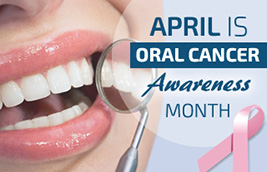

The U.S. Department of Health and Human services has deemed April as Oral Cancer Awareness Month. Approximately 35,000 Americans are diagnosed each year with this largely preventable type of cancer that affects the mouth and/or part of the throat. Most oral cancers are related to tobacco use, alcohol use, or both. Men face twice the risk of developing oral cancer as women, and men who are over age 50 face the greatest risk, says the American Cancer Society.
Mouth cancer can occur on the:
Mouth cancer is one of several types of cancer grouped in a category called head and neck cancers. Mouth cancer and other head and neck cancers are often treated similarly.
Symptoms
Causes
Mouth cancer occurs when cells on your lips or in your mouth develop changes (called mutations ) in their DNA. These mutations allow cancer cells to continue growing and dividing when healthy cells would die. The accumulating abnormal mouth cancer cells can form a tumor. With time, they may spread inside the mouth and on to other areas of the head and neck or other parts of the body. Most oral cancers are called squamous cell carcinomas.
Risk factors
Diagnosis
Once mouth cancer is diagnosed, your doctor works to determine the stage of the cancer. That can be done through a procedure called endoscopy and through various types of imaging such as x-rays, CT scans, MRI and PET scans (positron emission tomography), among others. Your doctor will determine which of these tests are appropriate based on your condition.
Treatment
Treatment for mouth cancer depends on your cancer’s location and stage, as well as your overall health. Treatment options include surgery, chemotherapy and radiation. You will need to discuss your options with your doctor.
Surgery carries a risk of bleeding and infection. It can often affect your appearance, as well as your ability to speak, eat and swallow. You may need a tube to help you eat, drink and take medicine. For short-term use, the tube may be inserted through your nose and into your stomach. Longer term, a tube may be inserted through your skin and into your stomach. You may also require a procedure to insert a breathing tube through your neck (tracheostomy). This breathing tube is usually temporary.
Please make an appointment with your doctor or dentist if you have any persistent signs and symptoms that bother you and last more than two weeks. Your doctor will likely investigate other more common causes for your signs and symptoms first, such as an infection. It is very important when at the dentist to make sure he or she do a thorough exam of your mouth and tongue for cancer. Many of us routinely see a dentist at least twice a year, so between the dentist and the hygienist, you should be getting a complete exam. Do not be afraid to request an exam if you don’t get one. Always be your own patient advocate!
Sources: www.healthfinder.gov | www.mayoclinic.org